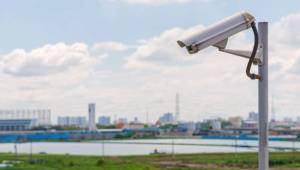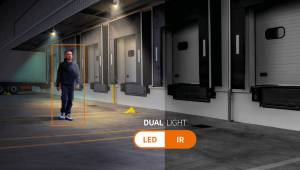 More than 40 years ago fire detection systems appeared in the security market, however technological advances have transformed them to be used in different types of spaces according to the needs.
More than 40 years ago fire detection systems appeared in the security market, however technological advances have transformed them to be used in different types of spaces according to the needs. Today the intelligence and speed of response differentiates its use and implementation.
by Ana María Restrepo
Earthquakes and maritime movements, volcanic eruptions and fires are some of the greatest natural disasters that have hit humanity throughout its history; and although many of them cannot be predicted exactly, such as the last earthquake of 7.9 degrees on the Ricther scale in Peru, (which left more than 500 victims); other tragedies can be detected earlier such as fires in buildings, warehouses and homes.
A few years ago, in Latin American cities such as Bogotá and Buenos Aires, fires in nightlife venues caused great human and material losses, which could have been avoided if these nightclubs had had a fire detection system.
In recent days, in the Justice Building of Medellín, Colombia, a conflagration occurred at four in the morning, and due to the time of the fire no person was injured or killed, but it was possible to destroy part of the physical file of Court 28 of the municipal circuit and some computers. It should be noted that in this building the free versions of the demobilized former paramilitary leaders who are being held in the Maximum Security Prison of Itagüí are developed.
In the same way, the flames burned in Malaga, Spain, much of the facilities of a local station while a program was being broadcast, fortunately no one was injured. Also, at the Cilicán International Airport in Sinaloa, Mexico, a small plane suffered a fire at the time of landing maneuvers, but none of the people involved was injured, contrary to what happened on July 5 when a Jet Sabré caused an accident in this same station and three members of the crew lost their lives and six more people.
Natural disaster
Many of the cases presented because of a conflagration may not be prevented as happened in the case of airplanes, however there are some events such as in the case of the court, the station or the night bars, where the lack of foresight and fire safety systems can cost your life.
Following these events, many companies and individuals have decided to install fire detection systems to help prevent incidents.
Currently fire detection systems can be used in any space, moreover, there are models for pharmacies, textile centers, hospitals, large industries, among others; with special features such as alarms, anti-vandalism protection or fast and slow fire detectors. There are also different kinds of automatic devices such as ionic and photoelectric devices that detect smoke, thermal devices that detect an increase in temperature, and ultraviolet and infrared devices that detect flames.
One aspect to keep in mind is that smoke detectors are not new. This technology has existed since the 60s and since that time it has been advancing in order to provide more and more a better protection system.
To talk about the progress that has been made on this issue and at the same time carry out an analysis of the Latin American situation, VENTAS DE SEGURIDAD interviewed Mimmo Micali, director for Latin America of Securiton, Alfredo Luciano, general director in Puerto Rico of ADI and Carlos Zorrilla, regional sales manager in Mexico of Honeywell.
Smoke detectors and their advances
In the 70s, the battery-based smoke detector was made available to the consumer, today with the advancement of technology, man has designed automatic detection systems that imitate the human senses based on the fact that all combustion produces smoke, gases, flames and heat.
According to Mimmo Micali, the detectors have greatly improved their reliability due to several technologies that have been implemented to them. "Through dynamic filters, or rather, algorithmic filters, it is possible to evaluate in a combustion phase whether the particles found in the optical chamber of a detector coincide with a type of fire, excluding false alarms caused by dust, cigarette smoke or other particles."
These devices have also been given the character of intelligent because they can inform the panels (CPU) of the events they detect without the need for the control panel to be the brain, at the same time that they are identified through a logical direction, as Alfredo Luciano and Micali explain.
Smart detectors have a microprocessor or a chip that discriminates situations and cases, which not only allows the detection of incidents and their type of smoke or flame, but can also isolate a short circuit and thus prevent several detectors from stopping working.
Detection systems
Fire protection has developed two systems that have been the most used in recent years, however as in the case of wired and wireless communications, one of these two detectors is giving way due to the current characteristics and needs of the industry.
The main difference between conventional and directional systems lies in the fact that in a conventional system the control panel only identifies the area where the alarm was presented, while in the directional one each detector and each module have a unique address that allows to establish the exact place of the incident.
In Latin America the use of intelligent (addressable) detectors has been on the rise, and as Luciano asserts, these will soon replace the conventional system in large applications. For his part, Mimmo thinks that although conventional detectors may be cheaper, the prices of smart detectors are getting lower and lower, which makes these systems more affordable and competitive in the market due to all the benefits they provide to consumers.
For his part, Carlos Zorrilla believes that the market in Latin America is becoming more and more specialized; "We are living a stage in which it is not only interesting to comply with local certifications, but not to fully comply with international standards, that is why intelligent sensors are being requested, because these give us greater precision and speed of response, they can also share information between them and the control panel."
Both Micali and Luciano believe that in Latin America the culture of fire prevention and the creation of regulations that regulate it is on the rise in Mexico, Argentina, Chile, Brazil and Colombia. Mas Zorrilla explains that in the region there is a latent risk, and that is that of the detectors and systems of poor quality that are being imported from China and that intend to introduce them as intelligent devices, which do not have official validations such as UL or FM.
Smart vs. Conventional
The market for fire and smoke detectors has been varying as explained by these professionals due to the implementation of new technologies, which make some devices better instruments than others for some spaces, however the use of conventional detectors continues to be representative in small spaces.
Likewise, the directional system has continued to increase its coverage due to its decrease in value and its technological characteristics, such as its ability to respond faster and more accurately to a fire outbreak, have positioned it in the market in those complex and large facilities.
It should be noted, as Luciano states, that the directional system offers advantages in terms of reducing wiring and the location of the alarm by detector instead of by zone. "This is how the detector having an assigned address allows to determine the exact location of the incident."
For their part, conventional detectors do not have the ability to identify themselves, or compare internal values with the panel, or even share information with other devices as Carlos Zorrilla explains, because several of these devices must be reported to an intelligent module and this is the one that executes action.
However, due to the reduction of the costs of microprocessors, some manufacturers have installed these elements in conventional detectors, which help improve conventional ones and reduce the technological gap between the two leading systems in fire detection, allowing a faster response speed than they had previously.
Digital and analog addressable detectors
Addressable devices are also divided into two groups, digital and analog, which have a series of differences that make them compete with each other.
For Micali the main difference between these two detectors is that a digital one only sends the information of its position, while the analog has an internal processor that allows it through algorithms to perform a series of evaluations on the process of a combustion, thus improving the speed of the response to the incident, in addition to maintaining a very low quota of false alarms. Likewise, this device notifies the system when it needs to receive maintenance or in what state of dirt it is.
For many manufacturers of fire fighting equipment, smart detectors have several advantages (which we have already mentioned) in addition to low energy consumption, however their biggest disadvantage lies in the fact that their price is high and much higher than that of conventional detectors.
Detectors for each space
Over the years, the fire safety industry has advanced in its creations, implementing special systems to use in certain types of spaces such as pharmacies, supermarkets, laboratories, kitchens, industrial areas, offices, schools, among others; which have special characteristics that support the prevention and detection of fires. Within these devices we can find, as we mentioned at the beginning, those that detect flame, smoke or temperature.
According to Alfredo Luciano and Mimmo Micali when we talk about the most used detectors we can say that ionized (for smoke), photoelectric (smoke) and thermal detectors are the most common, but it should be differentiated that not all can be used in the same spaces. For example, ionized ones should be installed in those places where there may be a fast fire and little smoke, since the fire generates a white smoke as in paper or chemical factories.
For its part, the photoelectric device is ideal for the detection of slow fire with the production of a lot of black smoke, which can result in facilities where plastic material exists such as industries, residences and offices. Meanwhile the thermal detector is implemented in spaces where flames can be generated, where the fire develops slowly but with a lot of smoke, and where, due to the contamination of the place, it is not possible to use an optical detector as it happens in a kitchen or in a machine room.
However, Mimmo explains that in high or industrial places it is necessary to evaluate if these detectors can work correctly. "Today there are several special detectors for these types of applications such as suction system or linear temperature detector, developed for these places where common detectors are not very effective."
Integration with other systems?
The integration of the different security systems such as CCTV, alarms or biometrics, allow greater efficiency at the time of monitoring and protecting some spaces, however the fire alarm system is the only one that cannot be integrated with the others, due to the high lightness with which it must respond to events.
For Luciano, the existing regulations of fire safety have restrictions towards fire detectors being operated remotely, but these rules do allow fire systems to share information with other safety technologies, because being the fire system the one that has "in its hands" the care of the lives of all the people who are in the place is makes it the most essential subsystem.
For his part, Micali maintains that "it is important to pass an eventual alarm information to a graphic system and thus integrate into other security systems, and that the operations are carried out from the fire detection center."
Conversely, Zorrilla explains that the standards do allow these systems to be operated and controlled remotely, but such control systems must meet certain requirements and with the relevant approvals such as UL or FM. "The problem is that there are not many systems with these features available on the market."
Fire security in Latin America
As in other security systems, Latin America has begun to take steps in the development and implementation of technologies that provide each of the countries with safe solutions that protect the lives of their inhabitants and their assets, and that in one way or another improve their economies and their social development. In this case, fire safety is no exception, because as we mentioned earlier, Argentina, Mexico, Brazil, Colombia and Chile already have, or special systems and nomas are being created that regulate the use and implementation of this type of security.
In the region and thanks to the growth of some economies, the fire safety market tends to grow. Today there are more and more foreign investments in infrastructure such as hotels and smart buildings where having intelligent fire detection systems is paramount.
However, the implementation of wireless technologies for the use of smart detectors in Latin America has not been well received, because as Micali and Luciano affirm, the high cost and ignorance of professionals in the sector against these wireless detectors make them little used.
Mimmo also explains that "a good wireless detector with its certifications is relatively expensive and in Latin America it is still cheaper to carry out a wired installation than to propose a good quality wireless system; although it may be interesting to mix a wireless system with a fixed system."
For his part, Carlos Zorrilla believes that the implementation and use of wireless detectors in Latin America is very little, because this technology suffers a lot with the type of construction that is done in the region, since steel is used in it, concrete, rod, reflective glass, marble, among others, which affect the radio frequency, reducing its reception capacity and therefore the number of devices they can handle. Therefore, wireless systems are currently very expensive and unreliable. However, Zorrilla explains that this technology is used when the building in question is a historic patromony and the installation of any type of pipe or apparent wiring is not allowed.

























Leave your comment